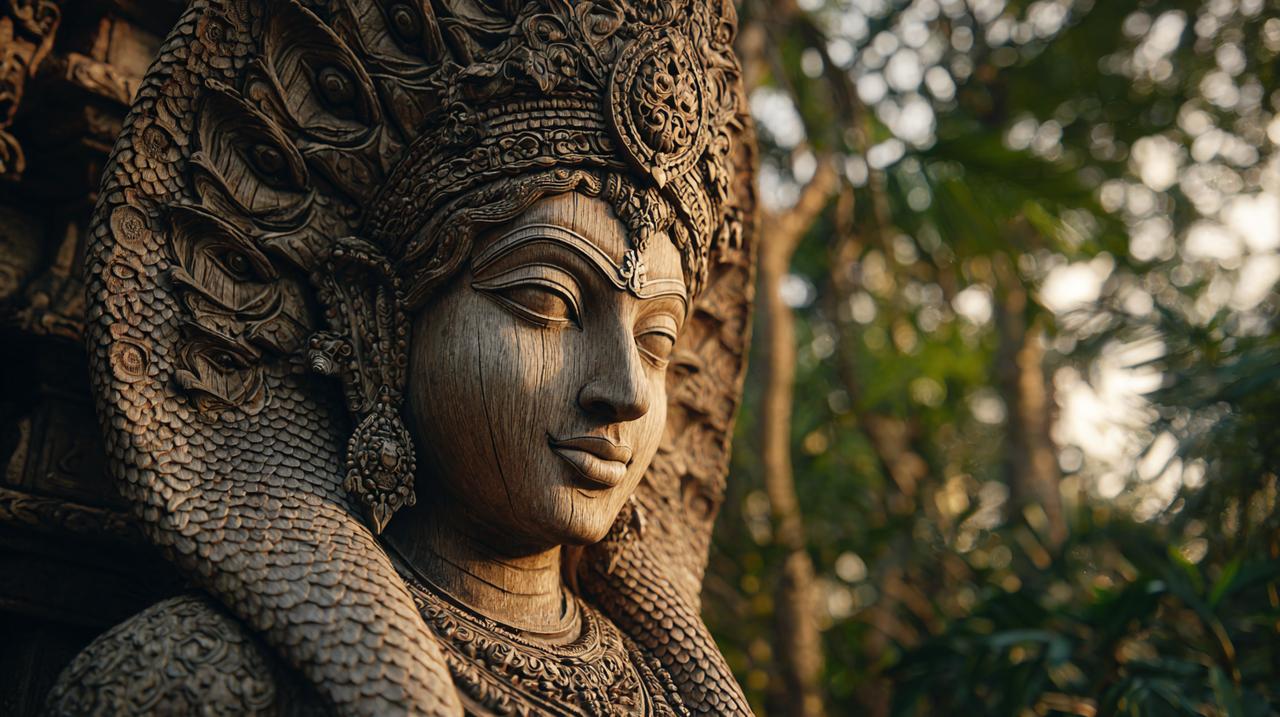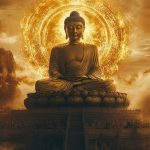Naga Kanya: Serpent Goddess of Wisdom, Protection, and Transformation
Beneath the still surface of a pond, roots reach deep, quietly drawing life from the earth. A fallen leaf, carried by the current, gently returns to the water, nourishing new growth. This is the quiet way of nature: a constant flow of change, wisdom, and enduring strength. In this gentle rhythm, we find a reflection of Naga Kanya, the serpent goddess. Her ancient presence whispers of the quiet, transformative power woven into the world around us.
Waters of Ancient Wisdom: Naga Kanya’s Presence
Like a hidden spring that nourishes diverse landscapes, Naga Kanya’s essence flows through various ancient traditions. Her imagery, often a human torso emerging from the coiled body of a serpent, speaks of a deep connection between the earthly and the mystical. She is not merely a figure of worship but a living metaphor for the forces that shape our existence.
Echoes in 「Hindu Mythology Deities」
Across the many paths of Hindu traditions, Naga Kanya is respected as a quiet guardian. She is often depicted as a benevolent queen of the Nagas, mythical serpent beings who inhabit the underworld (Patala). These beings possess deep wisdom and quiet strength.
They are linked to water bodies, fertility, and the vital life force, much like the unseen currents that sustain a river. Her presence often signifies protection, particularly of sacred waters and hidden treasures.
Reverence Among 「Buddhist Deities」
The gentle influence of Naga Kanya extends into Buddhist lore, where Nagas are seen as protectors of the Dharma. Stories tell of Nagas shielding the Buddha from storms during meditation, symbolizing inner resilience against external turmoil.
Naga Kanya, in this context, embodies the wisdom that arises from deep meditation and the protective qualities of enlightenment. Her form reminds us that truth can emerge from unexpected, often 'unseen' places, much like a lotus blooming from muddy waters.
The Serpent’s Unfolding Truths: Wisdom and Renewal
A serpent sheds its skin, not in an act of loss, but of necessary renewal. This natural cycle offers a quiet lesson, central to understanding Naga Kanya. She represents the inherent capacity for change and rebirth within all living things, including ourselves.
Symbolism of the 「Serpent Goddess」
The serpent, in many cultures, is a symbol of 「primal energy」, healing, and rebirth. For Naga Kanya, these quiet meanings grow deeper. Her serpentine lower body connects her to the earth's ancient energies, to the cycles of decay and growth.
The human upper body signifies conscious awareness and spiritual insight. Together, they represent the integration of instinctual wisdom with higher consciousness, a balance found in the quiet observation of nature itself.
Inner Currents of Knowing
Naga Kanya invites us to look inward, to the deep currents of our own intuition. Just as a river carves its path through stone over eons, our inner wisdom, if listened to, can guide us through life's challenges.
She symbolizes the knowledge that isn't learned from books, but felt in the gut. It is a knowing that arises from a deep connection to the self and the natural world. This innate wisdom is a source of quiet strength.
Silent Guardianship: The 「Divine Feminine」 in Nature
The earth itself is a nurturing force, providing sustenance and shelter without asking for anything in return. Naga Kanya embodies this silent, protective aspect of the divine feminine. Her guardianship is not one of overt force, but of subtle, enduring presence.
Nurturing Protection
Naga Kanya's protective embrace is akin to the deep, cool shade offered by an ancient tree on a hot day. It is a shelter not just from physical harm, but from spiritual discord. She is often seen guarding sacred knowledge and places, representing the preservation of purity and truth.
This protection is a gentle reminder that true strength often lies in quiet resilience and unwavering presence.
Reflections in Art and the 「Naga Kanya Statue」
A carefully carved 「naga kanya statue」 captures this essence, often depicting her with a serene expression, her multi-headed cobra hood spread like a canopy. These statues are not merely decorative; they are focal points for contemplation.
Observing such a piece can invite a moment of quiet reflection, allowing one to connect with the qualities of wisdom and protection she represents. Each curve of the serpent, each detail of her form, serves as a silent teacher.

The Path of Flow: 「Spiritual Transformation」 Through Her Essence
The journey of a mountain stream, from its trickling source to a powerful river, is a testament to continuous change and adaptation. Naga Kanya, through her symbolism, guides us on a similar path of personal evolution.
Embracing Cycles of Change
Life, like nature, is a series of cycles: beginnings and endings, growth and dormancy. Naga Kanya teaches us to embrace this natural rhythm, to understand that shedding the old is necessary for new growth. This process of 「Spiritual Transformation」 is not always comfortable, much like a serpent's skin-shedding, but it is essential for renewal.
She encourages us to release what no longer serves us, allowing space for deeper truths to emerge.
Cultivating Inner Resilience
The serpent's ability to adapt to various environments speaks of quiet resilience. Naga Kanya's essence inspires us to cultivate our own inner strength. She helps us navigate life's inevitable changes with grace and adaptability.
By observing the unwavering flow of nature, we learn to bend without breaking, to find stillness amidst movement, and to trust in our own capacity to regenerate.
The quiet wisdom of Naga Kanya, like the enduring path of a river, reminds us that truth is often found not in grand pronouncements, but in the subtle shifts and constant renewal of the natural world. Her essence invites us to look within, to connect with our own wellspring of wisdom and resilience. To truly understand her is to understand the silent teachers all around us, and the quiet journey of transformation that unfolds within each moment. For those who seek to deepen this connection, exploring representations of Naga Kanya, perhaps a 「naga kanya statue」 or other sacred art, can serve as a gentle anchor for contemplation and inner discovery.
💡 Frequently Asked Questions
Naga Kanya symbolizes the quiet, transformative power of nature, encompassing wisdom, protection, and renewal. Her imagery, often a human torso emerging from a serpent's body, represents the deep connection between the earthly and mystical, embodying primal energy, healing, and rebirth.
In Hindu traditions, Naga Kanya is respected as a benevolent queen of the Nagas, mythical serpent beings associated with underworlds, water bodies, fertility, and life force. She is seen as a quiet guardian, often signifying protection, particularly of sacred waters and hidden treasures.
Within Buddhist lore, Naga Kanya embodies the wisdom that arises from deep meditation and the protective qualities of enlightenment. Nagas, including Naga Kanya, are seen as protectors of the Dharma, with stories depicting them shielding the Buddha, symbolizing inner resilience against external turmoil.
The serpent shedding its skin is a central metaphor for Naga Kanya, representing the inherent capacity for change, renewal, and rebirth within all living things. It signifies the necessary process of letting go of the old to make way for new growth and transformation.
Naga Kanya guides us on a path of personal evolution by teaching us to embrace life's natural cycles of change and renewal. Her essence inspires us to cultivate inner strength and adaptability, encouraging us to release what no longer serves us and to trust our capacity to regenerate, much like the silent resilience of a serpent.








